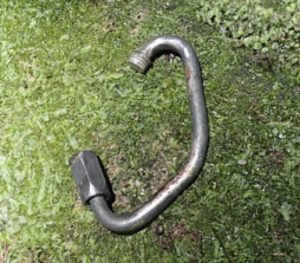Date of Event: 2/1/2019
Canyon involved: Bjelkes Mind
Region: Blue Mountains
Country: Australia
Submitted by: Henry Moon
Source: report on canyoning.org.au
Injury: No injury
Cause: Rappel ring failure
Description of Event:The incident occurred in a sandstone slot canyon in the Blue Mountains that is reasonably well known, but not particularly popular due to its remoteness. There are probably only a few dozen groups that visit it each year. It is popular enough to have fixed anchors (natural anchors with slings and maillons). The group that had this near miss were all experienced canyoners.
The first person in the group checked the anchor and rigged the rope. The rappel ring was a Maillon Rapide brand, zinc plated 6mm steel Delta (triangular) maillon with a rated Working Load Limit (WLL) of 250kg / Breaking Load of 1250kg when new. The nut on the maillon was not tight when checked, but was then tightly closed by hand. The maillon didn’t appear to be deformed. The first person descended without incident.
The next member of the party then descended. They also noticed nothing wrong with the maillon before setting off. They were not heavy and did not do anything unusual or shock load the anchor while descending. As shown in the photo below, the maillon failed catastrophically during this descent. Thankfully the rope remained attached to the anchor until the abseiler reached the ground; otherwise the person would have suffered a serious fall.
Lessons:
Given that the maillon that failed was a recognised brand, a reasonable diametre, and being used well within its safe working load, this incident is particularly concerning. It highlights how easily a core component of an abseiling anchor can fail, with potentially catastrophic consequences. Some of the lessons I have taken from this incident include:
1) Always check each anchor. Examine the full length of any tape / webbing to ensure it is satisfactory. Check maillons or other components to ensure they are in reasonable condition, are of an adequate diametre, and are appropriately rated. You are trusting your life to the anchor. Based on appropriate safety margins, I recommend only using 5mm or larger maillons.
2) Maillons, like carabiners, lose the majority of their strength if the gate is open. In the case of a maillon, ensure the gate is screwed firmly shut. Check the screw thread is undamaged (if the thread is worn, the gate will no longer work, resulting in a dramatic loss of strength). If there is any possibility that the maillon is damaged, remove it. Position the maillon in such a way that it screws downwards to close (so can’t work loose).
3) Not all maillons are made equal. Walk into any hardware store and you can find a range of quick links for sale. These are superficially indistinguishable. Most of these are not tested and rated to a level that makes them safe for use as an anchor. If the maillon does not include stamped ratings that indicate an appropriate strength, remove it. Also note that maillons can come in both stainless steel, and zinc-coated versions. Only use stainless steel maillons in moist canyon environments as corrosion can seriously reduce strength. The stainless steel versions are also much stronger than zinc coated maillons. For instance, the 6mm Delta Maillon Rapide in stainless steel has a WLL of 450kgs. The identical zinc coated steel version has a WLL of just 250kgs.
4) Consider using alternatives for fixed anchors, such as rappel rings. These rings are not only stronger than maillons because they don’t have a screw thread / gate that can corrode or be damaged, but they are also made of aluminium alloys, so don’t corrode. Additionally, unlike quick links there are not cheap hardware store knock-offs available, so they are easier to visually check.
ICAD Analysis:
Anchor failures intuitively pose a high risk of death or serious injury. In this case, the party acted appropriately to evaluate the anchor and integrity. However, keep in mind that a Working Load Limit of 250 kg when new is ~2.4 KN, and that the breaking strength of 1250 kg is ~12 KN when new/undamaged/uncorroded with a completely closed and secure gate. Although in theory this is a sufficient safety factor for one person, stainless steel/aluminum hardware with higher ratings are available for not much more cost in actual terms, considering that if the anchor hardware were to fail, consequences could be catastrophic.
Although systems will fail at their weakest point, and we cannot always control the weakest link/point in a system, when we can control and mitigate it, we should strongly consider it. Anchor hardware failures have been known to occur in places like Death Valley, where webbing looks brand new, but high UV exposure has caused inspected, seemingly good quality and good condition webbing, to fail unexpectedly even after rappelers of higher weight have gone first without issue. Thus, while inspection of anchors and anchor equipment is mandatory for safety at each use, it is not necessarily sufficient to prevent an accident due to anchor or equipment failure. In these cases, we can only mitigate risks. Thus, when possible, anchor hardware should be used over software (eg. stainless steel over fabrics or fibers), and higher rated equipment should be used when feasible (eg. 20-40 kN SS quicklinks vs 1250 lbs zinc plated quick links). And ultimately, we should be prepared for incidents like these should we do everything in our power to be safe, but just get unlucky. Emergency signalling equipment (eg. Inreach, Spot, Cell Phone, etc) and equipment to deal with extended and unexpected stays in canyons supporting an injured person, are therefore critical to have on hand, even on “simple” or “easy” canyons.
